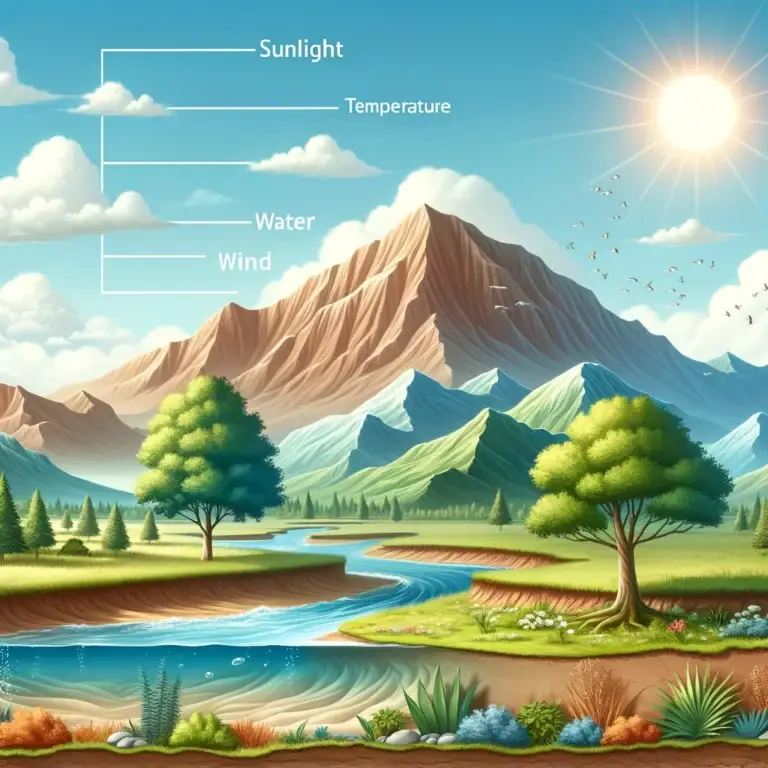Abiotic Factors
Table of Contents

What are Abiotic Factors?
Abiotic factors are the non-living parts of an environment that affect living things. These factors include physical and chemical elements like climate, water, and soil, which play key roles in the health and sustainability of habitats.
Examples of abiotic factors include:
- Climate: Temperature, sunlight, and rain shape where and how organisms live.
- Water: Its availability is crucial for life, influencing how organisms spread and behave.
- Soil: Its makeup supports different plants, which in turn support various animals.
- Topography: Mountains and valleys can change local climates and the types of plants and animals that thrive.
- Air and Wind: Air quality and wind patterns help spread plant seeds and affect breathing conditions for animals.
Overview of Abiotic Factors
Physical Abiotic Factors
Temperature: Temperature is a very important abiotic factor because it impacts how organisms function. How fast organisms act and grow and their chances of survival depend on their environment’s temperature. For instance, very hot or cold temperatures might stop certain organisms from living in a place. However, mild temperatures can allow many different kinds of life to thrive.
Light: This is essential for plants, algae, and some bacteria that use photosynthesis. They need light to turn carbon dioxide and water into glucose and oxygen. The type and amount of light also influence how different organisms behave and live. This includes when they migrate, how they eat, and their breeding patterns.
Water Availability: Water is vital for all life, but how much is available can shape what organisms live in an area. Water is always there in water environments, but on land, it can limit what lives there. The presence or lack of water affects how moist the soil is, how well plants grow, and whether land and water creatures survive.
Chemical Abiotic Factors
Soil Composition: Soil chemistry is crucial for plants. Nutrients like nitrogen, phosphorus, and potassium are key for plant health and growth. The soil’s pH can change how plants access these nutrients. Some plants do well in acidic soil, others in alkaline. Also, the soil’s minerals help determine its fertility and what plants can grow well in it.
Atmospheric Gases: The air mix and amount of gases affect how organisms live. Oxygen is vital for the breathing of most creatures that need air to survive, while carbon dioxide is key for plants, algae, and some bacteria that use it to make energy through photosynthesis. Although there is a lot of nitrogen in the air, it has to be turned into a form plants can use, like ammonia or nitrate, through natural processes or fertilizers. The balance of these gases is crucial for keeping ecosystems healthy and productive.
Geological Abiotic Factors
Topography: The shape of the land, like its mountains, valleys, plains, and slopes, greatly impacts the environment. For example, how water flows across an area can create different wet or dry spots. Sunlight also varies with the slope of the land; some areas get more light and can support different types of plants. Moreover, the landscape affects where animals and plants live, as some species are suited to specific places like high mountains or deep valleys.
Geological Substrate: The types of rocks and minerals in an area shape the soil’s properties. As different rocks and minerals break down, they create various soil types with unique nutrients and drainage abilities. For instance, soils in limestone areas are alkaline, while those in granite-rich regions are acidic. These soil characteristics influence what plants can grow, affecting the animals that rely on those plants for food and habitat.
Climate Patterns
Precipitation: The amount and type of precipitation, like rain, snow, sleet, or hail, along with how often it falls, are key factors in determining water availability for plants and animals. Areas with a lot of rain usually have lush vegetation and diverse animal life. On the other hand, dry regions with little rain can only support drought-resistant plants and animals adapted to those conditions. Additionally, precipitation affects soil moisture, river levels, and groundwater replenishment, all crucial for the health of land and water-based ecosystems.
Wind: Wind has a complex role in ecosystems. It affects the temperature and humidity, helps spread seeds and pollen, and shapes landscapes through erosion and deposition. Wind also influences how quickly water evaporates, and plants release moisture, affecting air and soil moisture levels. In coastal regions, wind helps move ocean currents, changing water temperatures and distributing nutrients, significantly impacting marine life.
Abiotic Disturbances
Natural Disturbances: These events, driven by natural processes, have a profound impact on ecosystems. For example, wildfires can alter species composition in an area, promote new growth, and modify nutrient cycles. Earthquakes reshape the landscape, creating new habitats and changing water courses.
Storms such as hurricanes and tornadoes can bring about rapid, severe changes, affecting both land and aquatic ecosystems through flooding, wind damage, and erosion. Although these natural disturbances can be initially destructive, they are vital for the continued dynamism and evolution of ecosystems, influencing biodiversity and community structure changes.Human Disturbances: Human activities are major sources of disturbance to ecosystems worldwide. For example, deforestation not only removes trees but also changes the habitat for many species. It affects local and global climate patterns and alters the carbon and water cycles.
Pollution, which involves releasing chemicals into the air, water, or soil, can degrade habitats, harm wildlife, and upset ecological balance. Additionally, urbanization, agriculture, and industrial activities transform the landscape, leading to habitat loss, fragmentation, and increased pressure on wildlife. These changes have profound impacts on the natural world.
Related Links
What is an Ecosystem?
What are Habitats?
Louisiana Purchase
The Photosynthesis Process